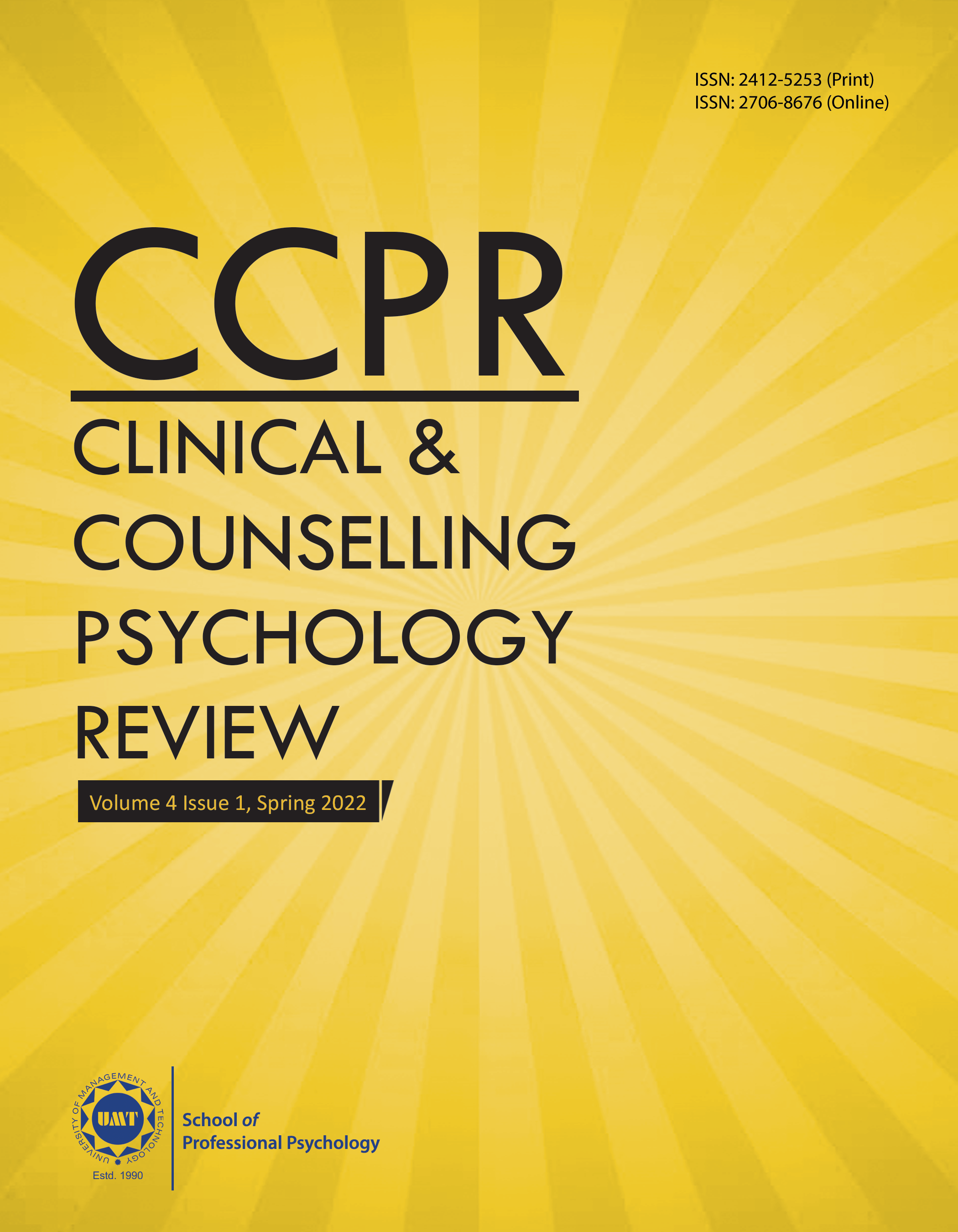Attachment, Interpersonal Relations Anxiety, and Life Satisfaction in University Students
Abstract
 Abstract Views: 159
Abstract Views: 159
The present study investigated the relationship between Adult Attachment, Interpersonal Relations Anxiety, and Life Satisfaction in university students. It was hypothesized that there is a significant relationship between the variables of the study. Moreover, a significant gender difference with respect to the study variables is expected in this research. Adult Attachment Scale, Interpersonal Relations Anxiety Questionnaire, and the Life Satisfaction Scale were used to analyze the study variables. The sample of the study comprised 200 university students of ages ranging between 19 to 25 (M=21.50, SD=.501) with an equal number of men (n=100) and women (n=100). The results indicated that interpersonal relations anxiety had significant negative correlation with life satisfaction. Furthermore, secure attachment was found to have a significant positive correlation with Life Satisfaction as well as it had negative correlation with the interpersonal relations anxiety, ambivalent, and avoidant attachment. Besides, avoidant attachment had significant positive correlation with interpersonal relations anxiety scores. In addition to it, ambivalent and avoidant attachment had significant negative correlation with secure attachment pattern. The t-test showed that men and women participants of the study don’t differ in terms of their life satisfaction and adult attachment patterns. but they do significantly differ in terms of their interpersonal anxiety. the results are discussed in the light of cultural context of Pakistan and existing literature.
Downloads
References
Adler, A. (1939). Individual psychology. In C. Murchison (Ed.), Psychologies of 1930 (pp. 395-405). Clark University Press.
Bartholomew, K., & Horowitz, L. M. (1991). Attachment styles among young adults: A test four Category model. Journal of Personality and Social Psychology, 61, 226-224.
Bowlby, J. (1979). Attachment and loss. Vol. II. Separation, anxiety, and anger. Basic Books.
Cress, V. C., & Lampman, C. (2007). Hardiness, stress, and health-promoting behaviors among college students. Psi Chi Journal of Undergraduate Research, 12(1), 18–23. https://doi.org/10.24839/1089-4136.JN12.1.18
Czapiński, J. (2004). Psychological theories of happiness. In J. Czapiński (Ed.). Positive psychology. Warsaw: PWN.
Dekovic, M., & Meeus, W. (1997). A sociological perspective on parent-adolescent disagreements. In R. L. Paikoff (Ed.), Shared views in the family during adolescence. Jossey-Bass, San Francisco.
Diener, E. D., Emmons, R. A., Larsen, R. J., & Griffin, S. (1985). The satisfaction with life scale. Journal of personality assessment, 49(1), 71-75. https://doi.org/10.1207/s15327752jpa4901_13
Diener, E., Suh, E. M., Smith, H., & Shao, L. (1995). National differences in reported subjective well-being: Why do they occur? Social Indicators Research, 34(1), 7-32. https://doi.org/10.1007/BF01078966
Diener, E., Oishi, S., & Lucas, R. E. (2003). Culture, personality, and well-being. Annual Review of Psychology, 54, 403–425.
Easterlin, R. A. (1995). Will raising the incomes of all increase the happiness of all? Journal of Economic Behavior & Organization, 27(1), 35-47.
Fraley, R.C., Brumbaugh, C. C., & Marks, M.J. (2005). The evolution and function of adult attachment: a comparative and phylogenetic analysis. Journal of Personality and Social Psychology, 89(5), 731-46. https://doi.org/10.1037/0022-3514.89.5.751
Hazen, C., & Shaver, P. R. (1987). Romantic love conceptualized as an attachment process Journal of Personality and Social Psychology, 52(3), 511-524.
La Guardia, J.G., Ryan, R.M., Couchman, C., & Deci, E.L. (2000). Within person variation in security of attachment: A self-determination theory perspective on attachment need fulfillment and well- being. Journal of Personality and Social Psychology, 79(3), 367-84. https://doi.org/10.1037/0022-3514.79.3.367
Ling, X., Jiang, G. R., & Xia, Q. (2008). Relationship between normal university freshmen’s adult attachment towards different subjects and subjective wellbeing. Chinese Journal of Clinical Psychology, 16, 71–73.
Mikulincer, M., & Shaver, P. R. (2007). Attachment in adulthood: Structure, dynamics, and change. Guilford Press.
Pierceall, E.A., & Keim, M.C. (2007). Stress and coping strategies among community college students. Community College Journal of Research and Practice, 31(9), 703-712. https://doi.org/10.1080/10668920600866579
Rohner, R. P. (2008). Introduction: Parental acceptance-rejection theory studies of intimate adult relationships. Cross-Cultural Research, 42(1), 5-12. https://doi.org/10.1177/1069397107309749
Ross, S. E., Niebling, B. C., & Heckert, T. M. (1999). Sources of stress among college students. College student journal, 33(2), 312-312.
Santrock, J.W. (1997). Life-span Development. (6th ed.). McGraw Hill Higher Education. Brown & Benchmark Publishers.
Torquati, J. C., & Raffaelli, M. (2004). Daily experiences of emotions and social contexts of securely and insecurely attached young adults. Journal of Adolescent Research, 19, 740–758. https://doi.org/10.1177/0743558403260023
van Buren, A. & Cooley, E.L. (2002). Attachment styles, view of self and negative affect. North American Journal of Psychology 4(3), 417-430.
Wearden, A. J., Lamberton, N., Crook, N., & Walsh, V. (2005). Adult attachment, alexithymia, and symptom reporting: An extension to the four category model of attachment. Journal of psychosomatic research, 58(3), 279-288. https://doi.org/10.1016/j.jpsychores.2004.09.010








